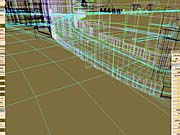Project Gotham Racing 2 Designer Diary #3
The latest installment in our ongoing series on the development of PGR2 focuses on city modeling.
This month, we hear from senior artists Julie McGurren, Derek Chapman, Paul Spencer, and Mark Sharratt about modeling cities for Project Gotham Racing 2.
City Modeling, From A to Z
By Julie McGurren, Derek Chapman, Paul Spencer, and Mark SharrattSenior Artists
We covered the interesting part last time--the research trips. But then it's back to the office for the painstaking task of building and implementing the information to make a racing environment for Gotham 2.
The first mission is to catalogue the research. With up to 6,000 photographs to go through, this is a major issue--you need to know exactly where a photograph is in the research store, as you will need it later! Maps are used for reference here, and also to refer to as the first modeling stage gets under way, which is building the street layouts.

Modeling for this is done in our own editor package (we'll talk about our tools in the next entry), and a clear street/area plan is laid out first, complete with heights. Although we need to try to be accurate, we will "tweak" some things later to make the layouts playable. For example, a narrow two-lane road with a central reservation might be more fun to race if the reservation were lowered so you could drive over it. Then the buildings are put in roughly--just as blocks at this stage.
This early mesh gives us a good impression of the overall area layout, and then the roads, grass, runoffs, curbs, barriers, rumble strips, and so on are built and textured. This drivable-area detail is essential to do first, as playability is very important. The playability is tested at this stage, and it's tweaked where necessary to make the best circuits and routes possible within the area.
Then the time-consuming task of building and texturing all the buildings begins. Each one is hand-modeled and -textured, with the detail being applied more and more until it really gets to look like a real city. This is a complex process, as the 3D engine has to be considered too. You need to make sure it all runs at 60fps with all the cars onscreen--a scary task!

Then the final track surface is checked, and any additional barriers needed are added. The street furniture, bins, and all those little details are added, along with a final polish of all the models and textures, to make the city seem alive. And finally, there's the task of lighting the city and adding the skyline. That seems like a relatively small detail, but it's hard to capture the real flavor of a city with just buildings--the lighting makes all the difference.
All this takes many, many months, and more than one artist can be working on one area too. By the end of Gotham 2, there will have been at least 300 man-months of work spent on creating the art for the game, and that's just the in-house work--eek!
For more information on Project Gotham Racing 2, check out our previous coverage of the game, which includes Q&As and more designer diaries.
Got a news tip or want to contact us directly? Email news@gamespot.com
Join the conversation